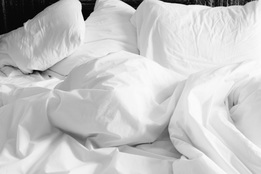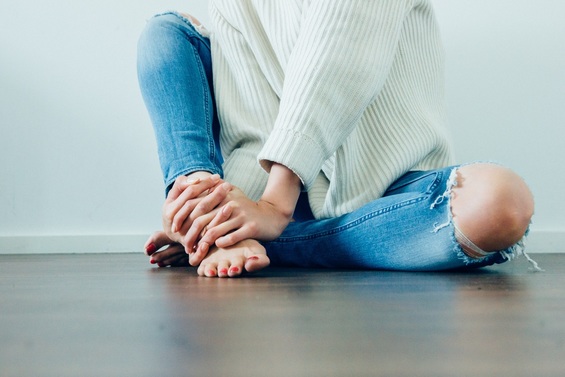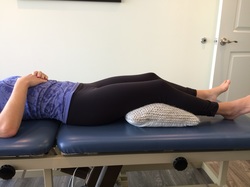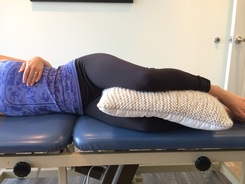|
I was recently teaching a workshop at a local gym when I asked the audience, "Who here has knee pain?" Nearly two-thirds of the crowd raised their hands. While this number may seem alarmingly high, greater than 60% of people report knee pain at some point during their adult life. Generalized knee pain is the 3rd most common reason Americans visit their doctor each year. In the clinic, I find that women are at a greater risk for knee pain than men. Simple postural cues and sleeping adjustments can be made to minimize the stresses placed across the knee each day. Why is knee pain so common?In a previous post, Knee Pain While Trail Running, I discussed why the knees are susceptible to injury. "The knee has motion in a single plane limiting the ability to absorb abnormal stresses from multiple angles. Since the knee only moves in one plane, the position of the hip and ankle have a profound effect on the forces that meet at the knee. ...When we don’t attend to the demands on the hip and ankle, the detriments often appear in the knee. If motion is lacking above or below the knee, the abnormal forces dispersed on the inherently unstable knee will result in pain." How to Adjust Sleeping Habits In general, women have wider hips than men. Wider hips increase the angle from the hips to the knees (this is known as the Q-angle). A large Q-angle predisposes the knees to collapse inward, which creates muscle imbalances across the knee joint. For this reason, clicking and popping can occur at the kneecap. The clicking and popping is not harmful, but it is sign that something is not moving properly. Whenever these signs appear, it is important to look at one's prolonged postures (i.e. sitting, driving, and/or sleeping) to find the cause. Since most people sleep between 6-8 hours each evening, let's start there! As simple sleeping adjustment to perform each evening is to place a pillow either between the knees or underneath the back of the knee. For side sleepers, the pillow between the knees will stop the top knee from collapsing in on the bottom one. The pillow decreases the Q-angle and minimizes the prolonged stress placed on the outer hip muscles while sleeping. For back sleepers, the pillow underneath the knees will stop the them from overextending and collapsing inward. Additionally, it will place the hip joint in a relaxed position, which protects the low back and knee joints. Remember, these sleeping adjustments are only as beneficial as your exercise and postural habits throughout the day. It is important to incorporate gluteal and hip strengthening exercises (see below) to keep the hips and core strong. Two Scientifically-based Exercises for Knee Pain
Are you experiencing knee or low back pain?Contact Heafner Health today to see if you are appropriate for physical therapy
P: 618-604-3293; E: [email protected]
10 Comments
Manuel Franco
8/29/2023 10:36:33 pm
I just want to say Thank You to everyone who supported me through the years. My name is Manuel Franco, New Berlin, Wisconsin. My story of how I won the Powerball lottery of $768.4M is a bit of a tale. I have been playing Powerball tickets for 6 years now since I turned 18. I bought my first ticket on my 18 birthday. I was feeling very lucky that day because I had contacted Dr. Odunga Michael to help me with the winning Powerball numbers. I really had that great great feeling that I looked at the camera wanting to wink at it. I only did a tiny part of it and trusted him. He gave me the numbers after I played a couple other tickets along with it for $10. I checked my ticket after the winnings came online and saw the numbers were correct including the Power play. I screamed for about 10 minutes because it felt like a dream. I had won $768.4M. You can check my winning testimony with the lottery officials just with my name search. Thank you Dr Odunga. Well, his email is [email protected] and you can also call or Whats-app him at +2348167159012 so you guys can contact him
Reply
Julie Leach
9/21/2023 12:52:59 am
Reply
10/20/2023 11:55:34 pm
This article offers helpful advice on how to treat knee discomfort while you sleep. Vancouver Sleep Clinic For ladies who are experiencing knee discomfort, the suggested modification might be a game-changer. It's wonderful to see workable answers for a frequent problem.
Reply
tonny
1/20/2024 01:03:00 am
For ladies who are experiencing knee discomfort, the suggested modification might be a game-changer. It’s wonderful to see workable answers for a frequent problem.https://officialovostore.com/
Reply
Alizar
1/20/2024 12:58:10 am
How to treat knee discomfort while you sleep. Vancouver Sleep Clinic For ladies who are experiencing knee discomfort, the suggested modification might be a game-changer. It's wonderful to see workable answers for a frequent problem. https://officialsp5derr.com/
Reply
4/18/2024 07:34:37 am
Chrome Hearts T-shirts boast premium quality and style, with prices ranging from affordable to luxurious, catering to diverse budgets and tastes.
Reply
4/18/2024 07:36:18 am
Chrome Hearts T-shirts come at a premium price, reflecting their high-quality craftsmanship, unique designs, and coveted brand status among fashion enthusiasts.
Reply
4/18/2024 07:37:35 am
The SP5DER T-shirt combines sleek design with comfort, making it a must-have addition to any wardrobe.
Reply
4/18/2024 07:42:59 am
OVO jackets fuse style and warmth seamlessly, making them a must-have for fashion-forward individuals seeking comfort and versatility.
Reply
Hailey Garcia
6/20/2024 10:57:49 pm
My name is Hailey Garcia and I am from New Jersey. My herpes virus turned to war after 2 years of living with it. I have tried different medical procedures to cure my herpes but to no avail. Most people think herpes is only a minor skin irritation of which herpes has long term effects on health and passes through the bloodstream and can be easily contracted through sexual intercourse. I knew I had herpes from the first day I started feeling itchy in my pubic area and the pain was very unbearable. I couldn't stand it anymore. After 2 years of trying other means to get rid of it, I had to contact Doctor Odunga to help me with a permanent cure. I saw his email and whats-app number from a testimony I read online from a lady who was also helped by him in curing infertility problems, I had faith and contacted him. He assured me of his work and I ordered his herbal medicine. Within 5 days, I didn't feel any pain anymore and within 2 weeks, my skin was all cleared and smooth. I am very grateful to you sir and I write this testimony as others have done to bring those having faith to you sir. If you have herpes or other similar disease and you want it cured, kindly contact Doctor Odunga, Whats-App (wa.me/+2348167159012) OR Email [email protected]
Reply
Leave a Reply. |
Heafner HealthPhysical Therapy Archives
April 2024
Categories |





 RSS Feed
RSS Feed
